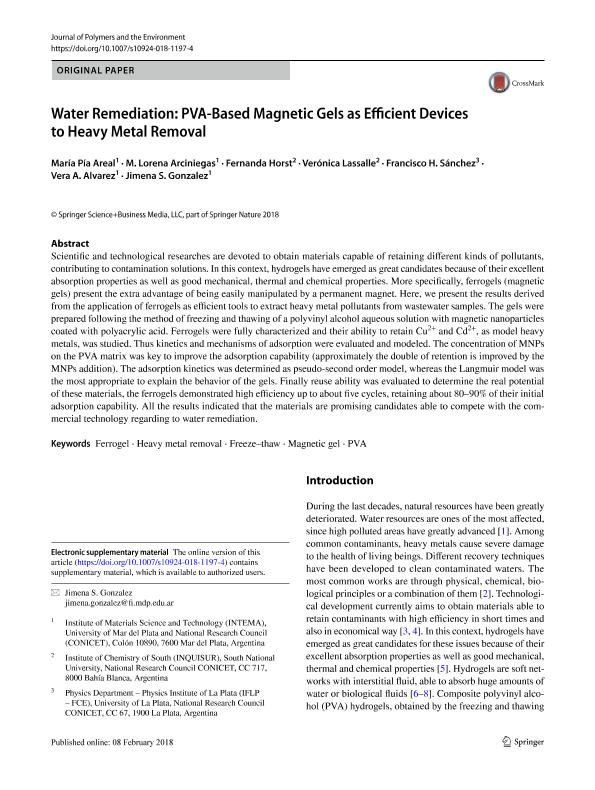Mostrar el registro sencillo del ítem
dc.contributor.author
Areal, Maria Pia

dc.contributor.author
Arciniegas Vaca, Magda Lorena

dc.contributor.author
Horst, María Fernanda

dc.contributor.author
Lassalle, Verónica Leticia

dc.contributor.author
Sánchez, Francisco Homero

dc.contributor.author
Alvarez, Vera Alejandra

dc.contributor.author
Gonzalez, Jimena Soledad

dc.date.available
2019-11-29T15:18:08Z
dc.date.issued
2018-02-08
dc.identifier.citation
Areal, Maria Pia; Arciniegas Vaca, Magda Lorena; Horst, María Fernanda; Lassalle, Verónica Leticia; Sánchez, Francisco Homero; et al.; Water remediation: PVA-based magnetic gels as efficient devices to heavy metal removal; Springer/Plenum Publishers; Journal of Polymers and the Environment; 26; 8; 8-2-2018; 3129-3138
dc.identifier.issn
1566-2543
dc.identifier.uri
http://hdl.handle.net/11336/90906
dc.description.abstract
Scientific and technological researches are devoted to obtain materials capable of retaining different kinds of pollutants, contributing to contamination solutions. In this context, hydrogels have emerged as great candidates because of their excellent absorption properties as well as good mechanical, thermal and chemical properties. More specifically, ferrogels (magnetic gels) present the extra advantage of being easily manipulated by a permanent magnet. Here, we present the results derived from the application of ferrogels as efficient tools to extract heavy metal pollutants from wastewater samples. The gels were prepared following the method of freezing and thawing of a polyvinyl alcohol aqueous solution with magnetic nanoparticles coated with polyacrylic acid. Ferrogels were fully characterized and their ability to retain Cu2+ and Cd2+, as model heavy metals, was studied. Thus kinetics and mechanisms of adsorption were evaluated and modeled. The concentration of MNPs on the PVA matrix was key to improve the adsorption capability (approximately the double of retention is improved by the MNPs addition). The adsorption kinetics was determined as pseudo-second order model, whereas the Langmuir model was the most appropriate to explain the behavior of the gels. Finally reuse ability was evaluated to determine the real potential of these materials, the ferrogels demonstrated high efficiency up to about five cycles, retaining about 80–90% of their initial adsorption capability. All the results indicated that the materials are promising candidates able to compete with the commercial technology regarding to water remediation.
dc.format
application/pdf
dc.language.iso
eng
dc.publisher
Springer/Plenum Publishers

dc.rights
info:eu-repo/semantics/openAccess
dc.rights.uri
https://creativecommons.org/licenses/by-nc-sa/2.5/ar/
dc.subject
Ferrogel
dc.subject
Freeze–thaw
dc.subject
Heavy metal removal
dc.subject
Magnetic gel
dc.subject
PVA
dc.subject.classification
Física de los Materiales Condensados

dc.subject.classification
Ciencias Físicas

dc.subject.classification
CIENCIAS NATURALES Y EXACTAS

dc.subject.classification
Compuestos

dc.subject.classification
Ingeniería de los Materiales

dc.subject.classification
INGENIERÍAS Y TECNOLOGÍAS

dc.title
Water remediation: PVA-based magnetic gels as efficient devices to heavy metal removal
dc.type
info:eu-repo/semantics/article
dc.type
info:ar-repo/semantics/artículo
dc.type
info:eu-repo/semantics/publishedVersion
dc.date.updated
2019-10-22T15:36:46Z
dc.journal.volume
26
dc.journal.number
8
dc.journal.pagination
3129-3138
dc.journal.pais
Estados Unidos

dc.journal.ciudad
New York
dc.description.fil
Fil: Areal, Maria Pia. Universidad Nacional de Mar del Plata; Argentina
dc.description.fil
Fil: Arciniegas Vaca, Magda Lorena. Consejo Nacional de Investigaciones Científicas y Técnicas. Centro Científico Tecnológico Conicet - Mar del Plata. Instituto de Investigaciones en Ciencia y Tecnología de Materiales. Universidad Nacional de Mar del Plata. Facultad de Ingeniería. Instituto de Investigaciones en Ciencia y Tecnología de Materiales; Argentina
dc.description.fil
Fil: Horst, María Fernanda. Consejo Nacional de Investigaciones Científicas y Técnicas. Centro Científico Tecnológico Conicet - Bahía Blanca. Instituto de Química del Sur. Universidad Nacional del Sur. Departamento de Química. Instituto de Química del Sur; Argentina
dc.description.fil
Fil: Lassalle, Verónica Leticia. Consejo Nacional de Investigaciones Científicas y Técnicas. Centro Científico Tecnológico Conicet - Bahía Blanca. Instituto de Química del Sur. Universidad Nacional del Sur. Departamento de Química. Instituto de Química del Sur; Argentina
dc.description.fil
Fil: Sánchez, Francisco Homero. Consejo Nacional de Investigaciones Científicas y Técnicas. Centro Científico Tecnológico Conicet - La Plata. Instituto de Física La Plata. Universidad Nacional de La Plata. Facultad de Ciencias Exactas. Instituto de Física La Plata; Argentina
dc.description.fil
Fil: Alvarez, Vera Alejandra. Consejo Nacional de Investigaciones Científicas y Técnicas. Centro Científico Tecnológico Conicet - Mar del Plata. Instituto de Investigaciones en Ciencia y Tecnología de Materiales. Universidad Nacional de Mar del Plata. Facultad de Ingeniería. Instituto de Investigaciones en Ciencia y Tecnología de Materiales; Argentina
dc.description.fil
Fil: Gonzalez, Jimena Soledad. Consejo Nacional de Investigaciones Científicas y Técnicas. Centro Científico Tecnológico Conicet - Mar del Plata. Instituto de Investigaciones en Ciencia y Tecnología de Materiales. Universidad Nacional de Mar del Plata. Facultad de Ingeniería. Instituto de Investigaciones en Ciencia y Tecnología de Materiales; Argentina
dc.journal.title
Journal of Polymers and the Environment

dc.relation.alternativeid
info:eu-repo/semantics/altIdentifier/url/http://link.springer.com/10.1007/s10924-018-1197-4
dc.relation.alternativeid
info:eu-repo/semantics/altIdentifier/doi/http://dx.doi.org/10.1007/s10924-018-1197-4
Archivos asociados
